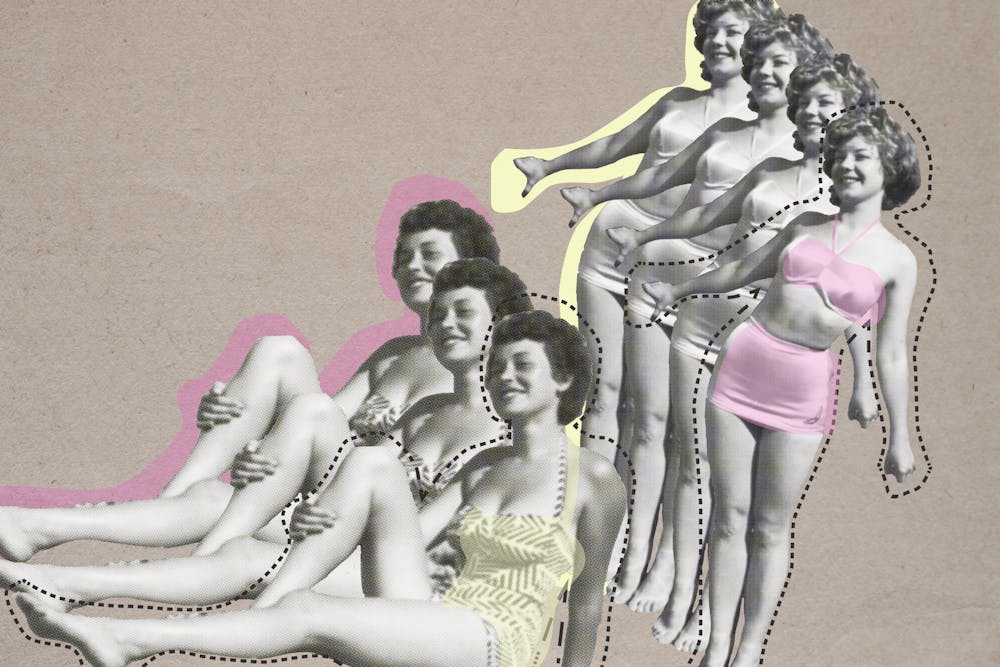For a long time, film, literature, and celebrities have constructed a European beauty standard centered around white men and women. Thick eyebrows, curly hair, big lips, aquiline noses, different body shapes, and of course darker skin tones were considered unattractive as recently as the early 2000s, forcing many people of color to alter their appearance to be deemed beautiful. But today, with prominent white internet personalities like Kylie Jenner and Belle Delphine, we're witnessing the abandonment of the ethnocentric beauty standards. Now women—regardless of ethnicity— are mimicking specific ethnic features and appropriating culture to increase their sex appeal and marketability. Non–Black women copy and profit off of Black features, and likewise, non–Asian women exploit Asian traditional dress and culture.
Mimesis is defined as the attempt to represent or imitate something. It's an accurate term to describe the actions of some white women and women of color who appropriate cultures that are not their own. For a quick pop cultural example, think Blackfishing—or the attempt to appear Black through make–up or plastic surgery. Celebrities like Ariana Grande, Nikita Dragun, and Bhad Bhabie have been accused of Blackfishing through ridiculous tans or photo editing that make their skin several shades darker.
Celebrities Kylie Jenner and Kim Kardashian offer an example of both mimesis and cultural appropriation working in tandem. The two apply their makeup and edit their photos to have darker skin, wear box braids and Bantu knots, and undergo plastic surgery procedures to alter their appearance to mimic that of natural Black features like larger lips and an hourglass body shape.

Photo courtesy of Buzzfeed
Altering their appearance to appear Black—or at the least “racially ambiguous”—is done with the intention to shed the innocent white woman image in favor of propagating the trope of a sexier, lustful image of Black women. By mimicking Black features and culture as a means to appear sexier, white women and non–Black women of color can increase their marketability while Black women face real consequences for their natural appearance like sexual violence and workplace discrimination coupled with respectability politics. This lends itself to constant policing, and Black women are even ridiculed about the health care they receive as a result.
Non–Black women of color mimicking Black features to increase their sex appeal is dangerous. It propagates dangerous tropes about Black women. The stereotype of the hypersexualized Black woman goes as far as the history of Sarah Baartman and many like her. Black women have been hypersexualized throughout history and to this day, and this effect furthers their oppression by casting them in opposition to white women's innocence. Furthermore, even subtly and unintentionally, mimicking Black features in ways that further sexualize Blackness has tangible impacts. Sexual violence against Black women becomes implicitly justified because people associate Black women with an inherent provocative and sexual nature.
Similar to Black women, Asian women's hypersexualization is reinforced by cultural appropriation through sexualizing traditional dress and Kawaii culture. Many non–Asian women have altered traditional dress like the Kimono for Japanese culture, the qipao for Chinese culture, the áo dài for Thai culture, and the sari for South Asian culture, to be more provocative and increase their sex appeal. Beyonce wore a sari. Kacey Musgraves wore an áo dài, both of which had the intention to depict themselves as mysteriously foreign and sexy. Not only does this directly advance the myth of exoticism; it is wholly disrespectful to Asian cultures.

Photo courtesy of CNN
Another example of increasing sex appeal via the exploitation of people of color's culture is the appropriation and sexualization of Kawaii culture. The most salient example of this is influencer Belle Delphine, who became famous for her gamer girl bath water and penchant for Kawaii outfits and anime. Belle Delphine increased her sex appeal by presenting herself in the exhausted trope of the oversexualized young Japanese girl despite being white. Her favorite cosplays? Underage Japanese anime characters, allowing her to capitalize on the intent to utilize the inherent over–sexualization of young Japanese women.
In the case of the fetishization of East Asian women specifically, sexualizing traditional dress and Kawaii culture reifies tropes about submissiveness and the "innocence" of Asian women. These stereotypes about Asian women are compounded when white women tie Asian culture with sexy Halloween costumes or Vogue photoshoots. The fetishization and sexualization of Asian women find their origin in dominance, colonialism, and control of imperial nations. Furthering this forced sexualization repeats the same violence for Asian women today.
We should not dismiss the tangible impacts on Black and Asian women when people copy ethnic features and appropriate cultures to increase their Instagram sex appeal. It may seem that wearing certain clothes or doing your makeup a certain way doesn't harm anyone because there are no explicit victims. But these microlevel acts of implicit racism add up to maintain and legitimize violent systems of racism and colonialism that oppress Black and Asian women.







